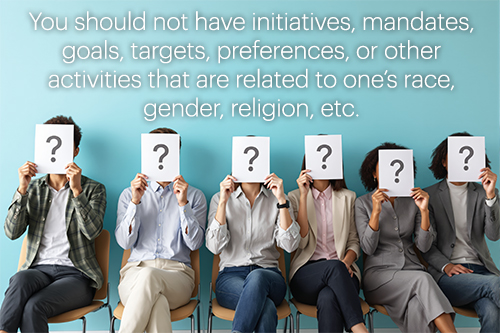Trump’s Executive Order and DEI in the Private Sector
By Sonal Shah, JD, Assistant Director, Employment Law Services
Published February 11, 2025
Within his first few days in office, President Trump issued several executive orders regarding Diversity, Equity and Inclusion (DE&I). One of the orders most relevant to employers is titled Ending Illegal Discrimination and Restoring Merit-Based Opportunity. Its stated purpose is to end illegal discrimination and restore merit-based opportunity. Among other things, the Order directs federal agencies to encourage private employers to eradicate illegal DEI. While we’ve provided some guidance on this topic, we’ve also received many questions from our private sector members on what this means for them and their DE&I initiatives.
 It's important to note that this Order does not replace or change federal laws, state laws, or Supreme Court precedent. However, it does signal the Trump administration’s focus on ensuring organizations do not violate existing anti-discrimination laws in their employment practices. Specifically, the administration has indicated that it plans to increase investigation and enforcement activities relating to DE&I programs that utilize discriminatory practices. While the administration has not yet provided clear direction on what it considers illegal DE&I, we hope the following provides some helpful guidance for our members.
It's important to note that this Order does not replace or change federal laws, state laws, or Supreme Court precedent. However, it does signal the Trump administration’s focus on ensuring organizations do not violate existing anti-discrimination laws in their employment practices. Specifically, the administration has indicated that it plans to increase investigation and enforcement activities relating to DE&I programs that utilize discriminatory practices. While the administration has not yet provided clear direction on what it considers illegal DE&I, we hope the following provides some helpful guidance for our members.
Things that HR Source has always advised were problematic under the guise of DE&I include:
- Looking to hire someone of a specific race, gender, sexual orientation, religion, etc. for a role. For example, saying we want to hire a Black or Asian person to be our executive director.
- Promoting someone less qualified because they are from an underrepresented group. For example, promoting a Muslim person into a manager role even though a Christian person has better experience and qualifications.
- Having any type of quota in place. For example, saying we want 40% of our administrative staff to be people of color or be comprised of 50% men.
- Making statements or assumptions about someone because of their race, gender, sexual orientation, religion, etc. For example, claiming during a training program that all men or Caucasian individuals are inherently racist.
Things that we may not have considered problematic in the past under the umbrella of DE&I, but may result in scrutiny under the current administration include:
- Use of the term diversity. For example, dictating to a recruiter that you want a diverse pool of applicants (and by which you mean, you want to ensure they include people of color).
- Celebrating certain cultural events such as Black History Month, Women’s Equality Day, Women’s History Month, and Asian American Pacific Islander Heritage Month.
- Having employer sponsored Employee Resource Groups (ERG) or affinity groups based on one’s race, gender, religion, etc. For example, having an ERG for women with children, those who are Jewish, or those who are Hispanic.
- Mentorship programs based on one’s race, gender, religion, etc. For example, having a mentorship program for young women or those who are Black.
- Pursuing or showing a preference for minority-owned business as business partners.
Things that were not and are still not problematic under the umbrella of DEI include:
- Increasing your talent pool by expanding where you recruit. For example, interviewing students from multiple colleges, including historically black colleges, posting openings in more diverse neighborhoods, or recruiting students from various industry groups, including those for people of color or those with disabilities.
- Implementing flexible work policies. For example, having policies that allow employees to set their own schedules or allowing them to work remotely.
- Making your workplace more accessible to those with disabilities. For example, installing ramps, creating wider hallways or doors, or adding adjustable desks and chairs.
- Having gender neutral bathrooms that are accessible to everyone.
- Making accommodations for your employee’s religious beliefs. For example, giving someone time and space to pray during the day or making an exception to your dress code so individuals are allowed to wear a hijab or yarmulke.
- Evaluating your pay practices to ensure pay truly is based on merit and not biases. For example, increasing the pay of women or people of color who you determine are being paid less than those in similar roles.
- Ensuring that everyone gets an opportunity to be heard and recognized. For example, ensuring colleagues don’t interrupt or talk over women or people with disabilities, or that people of color are given full credit for their contributions to a project.
To determine whether your DE&I-related policies and practices can withstand legal challenges, we recommend you review your related hiring practices, training courses, programs, and policies to ensure they are only focused on skill, education, experience, and other relevant merit-based factors. You should not have initiatives, mandates, goals, targets, preferences, or other activities that are related to one’s race, gender, religion, etc. Of course, this is an evolving area of the law, and we will do our best to keep you updated.
HR Source members with questions can contact us through the HR Hotline Online or at 800-448-4584.